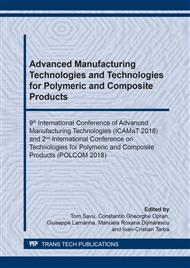[1]
J.B. Park, Y.K. Kim, The Biomedical Engineering Handbook, 2nd Edition, Vol. 1, Springer-Verlag, Germany, (2000).
Google Scholar
[2]
S.W. Teoh, Engineering materials for biomedical applications, World Scientific Publishing, Singapore, (2004).
Google Scholar
[3]
J. Park, R.S. Lakes, Biomaterials - An introduction, Springer-Verlag, New York, (2007).
Google Scholar
[4]
M.J. Jackson, T. Novakov, M.B. da Silva, Machining with Nanomaterials, Springer International Publishing, Switzerland, (2015).
Google Scholar
[5]
Y. Tsustumi, H. Doi, N. Nomura, M. Ashida, P. Chen, A.K. Awasaki, T. Hanawa, Surface Composition and Corrosion Resistance of Co-Cr Alloys Containing High Chromium, Mater. Tran. 57 (2016) 2033-2040.
DOI: 10.2320/matertrans.mi201514
Google Scholar
[6]
H. A. Zaman, S. Sharif, M. H. Idris, A. Kamarudin, Metallic Biomaterials for Medical Implant Applications A Review, Appl. Mech. Mater. 735 (2015) 19-25.
DOI: 10.4028/www.scientific.net/amm.735.19
Google Scholar
[7]
H.A. Zaman, S. Sharif, D-W. Kim, M.H. Idris, M.A. Suhaimi, Z. Tumurkhuyag, Machinability of Cobalt-based and Cobalt Chromium Molybdenum Alloys - A Review, Procedia Manuf. 11 (2017) 563-570.
DOI: 10.1016/j.promfg.2017.07.150
Google Scholar
[8]
S. Bruschi, A. Ghiotti, A. Bordin, Effect of the Process Parameters on the Machinability Characteristics of a CoCrMo Alloy, Key Eng. Mater. 554-557 (2013) 1976-1983.
DOI: 10.4028/www.scientific.net/kem.554-557.1976
Google Scholar
[9]
A. Bordin, A. Ghiotti, S. Bruschi, L. Facchini, F. Bucciotti, Machinability Characteristics of Wrought and EBM CoCrMo Alloys, Procedia CIRP 14 (2014) 89-94.
DOI: 10.1016/j.procir.2014.03.082
Google Scholar
[10]
A. M. Khorasani, I. Gibson, M. Goldberg, J. Nomani, G. Littlefair, Machinability of Metallic and Ceramic Biomaterials A review, Sci. of Adv. Mat. 8 (2016) 1491-1511.
DOI: 10.1166/sam.2016.2783
Google Scholar
[11]
K. Ueki, K. Ueda, T. Narushima, Precipitate Phases and Mechanical Properties of Heat-Treated ASTM F 90 Co-Cr-W-Ni Alloy, Key Eng. Mater. 616 (2014) 258-262.
DOI: 10.4028/www.scientific.net/kem.616.258
Google Scholar
[12]
K. Ueki, K. Ueda, T. Narushima, Microstructure and Mechanical Properties of Heat-Treated Co-20Cr-15W-10Ni Alloy for Biomedical Application, Metall. Mater. Trans. A 47-6 (2016) 2773-2782.
DOI: 10.1007/s11661-016-3488-5
Google Scholar
[13]
V.A. Kumar, R. K. Gupta, S.V.S.N. Murty, A. D. Prasad, Hot workability and microstructure control in Co20Cr15W10Ni cobalt-based superalloy, J. Alloys Compd. 676 (2016) 527-541.
DOI: 10.1016/j.jallcom.2016.03.186
Google Scholar
[14]
K. Ueki, K. Ueda, M. Nakai, T. Nakano, T. Narushima, Microstructural Changes During Plastic Deformation and Corrosion Properties of Biomedical Co-20Cr-15W-10Ni Alloy Heat-Treated at 873 K, Metall. Mater. Trans. A 49-6 (2018) 2393-2404.
DOI: 10.1007/s11661-018-4597-0
Google Scholar
[15]
E.P. DeGarmo, J.T. Black, R.A. Kohser, Materials and Processes in Manufacturing, John Wiley & Sons, (2003).
Google Scholar
[16]
N. E. Qehaja, A. H. Salihu, H. M. Zeqiri, H. Osmani, F. Zeqiri, Machinability of metals, methods and practical application, Annals of DAAAM 23 (2012) 29-32.
DOI: 10.2507/23rd.daaam.proceedings.007
Google Scholar
[17]
A.B. Novaes, S.L.S. Souza, R.R.M. Barros, K.K.Y. Pereira, G. Iezzi, A. Piattelli, Influence of implant surfaces on osseointegration, Braz. Dent. J. 21 (2010) 471-481.
DOI: 10.1590/s0103-64402010000600001
Google Scholar
[18]
G. Yingfei, P. Munoz de Escalona, A. Galloway, Influence of Cutting Parameters and Tool Wear on the Surface Integrity of Cobalt-Based Stellite 6 Alloy When Machined Under a Dry Cutting Environment, J. of Materi. Eng. and Perform. 26 (2017) 312-326.
DOI: 10.1007/s11665-016-2438-0
Google Scholar
[19]
A. Wennerberg, The role of surface roughness for implant incorporation in bone, Cells and Materials 9 (1999) 1-19.
Google Scholar
[20]
A.A. Kumar, P. Jignesh, K. D. Ashish, K. P. Udit, Cutting Parameters Effects On Cutting Force and Surface Roughness In Hard Turning Of AISI 52100 Steel With CBN Tool, IJRASET 3 (2015) 364-371.
Google Scholar
[21]
V.S. Sharma, S. Dhiman, R. Sehgal, S. K. Sharma, Estimation of cutting forces and surface roughness for hard turning using neural networks, J. Intell. Manuf. 19 (2008) 473-483.
DOI: 10.1007/s10845-008-0097-1
Google Scholar
[22]
J.S. Jadhav, B.R. Jadhav, Experimental study of Effect of Cutting Parameters on Cutting Force in Turning Process, IJIRAE 1 (2014) 240-248.
Google Scholar
[23]
C. Anghelache, M. G. R. Pagliacci, L. Prodan, Model de analiză macroeconomică bazat pe funcţia de regresie, Rev. Rom. de Stat. 1 (2013) 5-17.
Google Scholar


